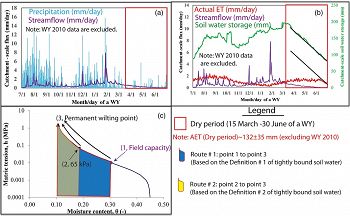Dwivedi et al., 2020
Vegetation source water identification using isotopic and hydrometric observations from a subhumid mountain catchment
Dwivedi R., Eastoe C., Knowles J.F., Wright W.E., Hamann L., Minor R., Mitra B., Meixner T., McIntosh J., Ferre P.A.T., Castro C., Niu G.-Y., Barron‐Gafford G.A., Abramson N., Papuga S.A., Stanley M., Hu J., Chorover J. (2020)
Ecohydrology 13(1): e2167
-
Catalina-Jemez, GRAD STUDENT
-
Catalina-Jemez, INVESTIGATOR
-
Catalina-Jemez, INVESTIGATOR
-
Catalina-Jemez, INVESTIGATOR
-
Catalina-Jemez, INVESTIGATOR
-
Catalina-Jemez, INVESTIGATOR, COLLABORATOR
-
Catalina-Jemez, INVESTIGATOR
-
Catalina-Jemez, STAFF
-
Catalina-Jemez, INVESTIGATOR
-
Catalina-Jemez, INVESTIGATOR
Abstract
(a) Daily precipitation and mean daily streamflow and (b) mean values of actual evapotranspiration, streamflow, and catchment‐scale soil water storage. (c) A soil water characteristic curve for sandy loam soil type, showing the two “routes” representing two soil water storage options based on different definitions of tightly bound soil water during the dry period. WY is water year.
This study coupled long‐term hydrometric and stable water isotope data to identify links between subsurface water storage and vegetation in a subhumid mountain catchment in Arizona, USA. Specific observations included catchment‐scale hydrologic fluxes and soil water storage and stable water isotopes from stream water, soil water, groundwater, and sap water from Arizona pine (Pinus arizonica) and Douglas fir (Pseudotsuga menziesii) individuals. Here, we find that tightly bound soil water was sufficient to meet dry period vegetation water demand when the former was defined in terms of field capacity as opposed to a matric tension threshold. This water was a mixture of summer and winter precipitation that predominates in both shallow and deep soil waters, and contributed significantly to streamflow. We also identified a less common mobile water type that did not contribute significantly to streamflow and was related to infiltration during isotopically depleted precipitation events. Although each water type was used by both Arizona pine and Douglas fir vegetation, the second water type was dominant in Douglas fir sap water. Therefore, we conclude that Arizona pine and Douglas fir can occupy different ecohydrological niches at this subhumid mountain location. Further, a lack of isotopic distinction between tightly bound and inferred mobile soil water signals that the ecohydrological water source separation hypothesis is not entirely applicable at this site. The results of this study broadly highlight how alternative definitions of tightly bound water can influence interpretation of data, and contribute to a more thorough understanding of interactions between subsurface storage and plant water dynamics.
Citation
Dwivedi R., Eastoe C., Knowles J.F., Wright W.E., Hamann L., Minor R., Mitra B., Meixner T., McIntosh J., Ferre P.A.T., Castro C., Niu G.-Y., Barron‐Gafford G.A., Abramson N., Papuga S.A., Stanley M., Hu J., Chorover J. (2020): Vegetation source water identification using isotopic and hydrometric observations from a subhumid mountain catchment. Ecohydrology 13(1): e2167. DOI: 10.1002/eco.2167
 This Paper/Book acknowledges NSF CZO grant support.
This Paper/Book acknowledges NSF CZO grant support.
Explore Further











